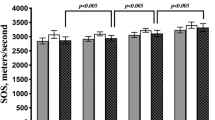Abstract
Copper and calcium are essential for human growth and development. The present study was conducted to evaluate the relationship between calcium and copper levels, as well as their relationship to age and anthropometry in 180 preschool children ages 2–5 years old. Serum copper levels were inversely correlated with age (r = −0.184, P = 0.032) and height (r = −0.175, P = 0.043) in the whole group and with height for age Z score only in male children (r = −0.291, P = 0.016). The correlation with age is not maintained when it is analyzed for gender. Serum calcium values in the total group were inversely correlated with weight (r = −0.153, P = 0.044) and weight for height Z score (r = −0.246, P = 0.001). No differences were found for gender in the levels of both metals. A negative relationship between serum calcium and copper was found only in male children (r = −0.339, P = 0.005). Studies are required in other populations and experimental designs that can explain an inverse relationship between serum calcium and copper levels.

Similar content being viewed by others
References
Ralph A, Arthur J (2000) Iron, zinc and other trace elements. In: Garrow JS, James WPT, Ralph A (eds) Human nutrition and dietetics, 10th edn. Churchill Livingstone, New York
Fleet JC (2000) Zinc, copper and manganese. In: Stipanuk M (ed) Biochemical and physiological aspects of human nutrition. Saunders, Philadelphia
Cordano A (1998) Clinical manifestations of nutritional copper deficiency in infants and children. Am J Clin Nutr 67(suppl):1012S–1016S
Castillo Durán C, Uauy R (1988) Copper deficiency impairs growth of infants recovering from malnutrition. Am J Clin Nutr 47:7l0–7l714
Insel P, Turner RE, Ross D (2004) Water and major minerals. In: Nutrition, 2nd edn. Jones and Bartlet, London
Pettifor JM (2004) Nutritional rickets: deficiency of vitamin D, calcium, or both? Am J Clin Nutr 80(6 Suppl):1725S–1729S
Harinarayan CV, Ramalakshmi T, Prasad UV et al (2007) High prevalence of low dietary calcium, high phytate consumption, and vitamin D deficiency in healthy south Indians. Am J Clin Nutr 85:1062–1067
Gracia B, De Plata C, Rueda A et al (2005) Efecto de la complementación con zinc en la velocidad de crecimiento en niños preescolares. Colomb Med 36(Suppl 3):31–40
Hamill PU, Drizd TC, Johnson CL et al (1979) Physical growth: National Center for Health Statistics percentiles. Am J Clin Nutr 32:607–629
Moore EW (1970) Ionized calcium in normal serum, ultrafiltrates and whole blood determined by ion-exchange electrodes. J Clin Invest 49:318–334
Gibson RS (1990) Assessment of copper status. In: Gibson RS (ed) Principles of nutritional assessment. Oxford University Press, New York, pp 520–526
Feliu M, Piñeiro LC et al (2005) Valores de referencia de cobre, zinc y selenio en niños. Acta Bioquím Clín Latinoam 39:459–462
Perrone L, Gialanella C, Moro R et al (1998) Zinc, copper and Iron in obese children and adolescents. Nutr Res 18:183–189
Khaldi F, Mansour B, Hedhili A et al (1995) Zincemia, cupremia and infection in malnourished children. Arch Pediatr 2(9):854–857
Stearns G, Knowlton C (1981) The lack of relationship between the calcium, protein and inorganic phosphorus of the serum of no-nepthritic children. J Biol Chem 92:639–648
Kelishadi R, Alikhassy H, Amiri M (2002) Zinc and copper status in children with high family risk of premature cardiovascular disease. Ann Saudi Med 22:291–294
Elcarte T, Elcarte R, Villa-Elizaga I et al (1997) Niveles séricos de Cobre y Zinc y su relación con factores de riesgo cardiovascular. Estudio epidemiológico en niños y adolescentes de Navarra. Anales 2:35–47
Silvia TM, Alarcòn OM, Alarcòn AO et al (2005) Niveles séricos de Cinc, Hierro y Cobre de preescolares que acuden a consulta en los ambulatorios urbanos tipo III de la cuidad de mérida. MedULA 12:1–4
Hatano S, Nishi Y, Usui T (1982) Copper levels in plasma and erythrocytes in healthy Japanese children and adults. Am J Clin Nutr 35:120–126
Mockus I, Caminos JE, Díaz E, Delgado M (1999) Niveles séricos de zinc, hierro y cobre en tres grupos de escolares Colombianos. Relación con algunos parámetros antropométricos. Pediatria 34:100–104
Bremner I, Beattie JH (1990) Metallothionein and the trace minerals. Ann Rev Nutr 10:63–83
Abu-Farsakh FA, Thajeel AH, Steiner S et al (1988) Sex-related correlation between zinc and calcium in serum. Clin Chem 34:467–468
Massie HR, Aiello VR, Shumway ME, Armstrong T (1990) Calcium, iron, copper, boron, collagen, and density changes in bone with aging in C57BL/6J male mice. Exp Gerontol 25(5):469–481
Navarro-Alarcon M, Reyes-Pérez A, Lopez-Garcia H et al (2006) Longitudinal study of serum zinc and copper levels in hemodialysis patients and their relation to biochemical markers. Biol Trace Elem Res 113(3):209–222
Kies C, Harms JM (1989) Copper absorption as affected by supplemental calcium, magnesium, manganese, selenium and potassium. Adv Exp Med Biol 258:45–58
Larsen T, Sandström B (1992) Effect of calcium, copper, and zinc levels in a rapeseed meal diet on mineral and trace element utilization in the rat. Biol Trace Elem Res 35(2):167–184
Saydam N, Adams TK et al (2002) Regulation of metallothionein transcription by the metal-responsive transcription factor MTF-1. J Biol Chem 277(23):20438–20445
Umemoto S, Tanaka M, Kawahara S et al (2004) Calcium antagonist reduces oxidative stress by upregulating Cu/Zn superoxide dismutase in stroke-prone spontaneously hypertensive rats. Hypertens Res 27(11):877–885
Acknowledgments
The authors thank Dr Jesús Larrahondo (PhD) and the chemistry laboratory of Centro de Investigación de la Caña de Azúcar de Colombia (Cenicaña) for their collaboration in metal measurements.
Author information
Authors and Affiliations
Corresponding author
Rights and permissions
About this article
Cite this article
Suárez-Ortegón, M.F., Jiménez, P., Mosquera, M. et al. Inverse Correlation Between Serum Calcium and Copper Levels in Male Urban Colombian Preschool Children: Relationships with Anthropometry and Age. Biol Trace Elem Res 144, 445–453 (2011). https://doi.org/10.1007/s12011-011-9132-8
Received:
Accepted:
Published:
Issue Date:
DOI: https://doi.org/10.1007/s12011-011-9132-8



